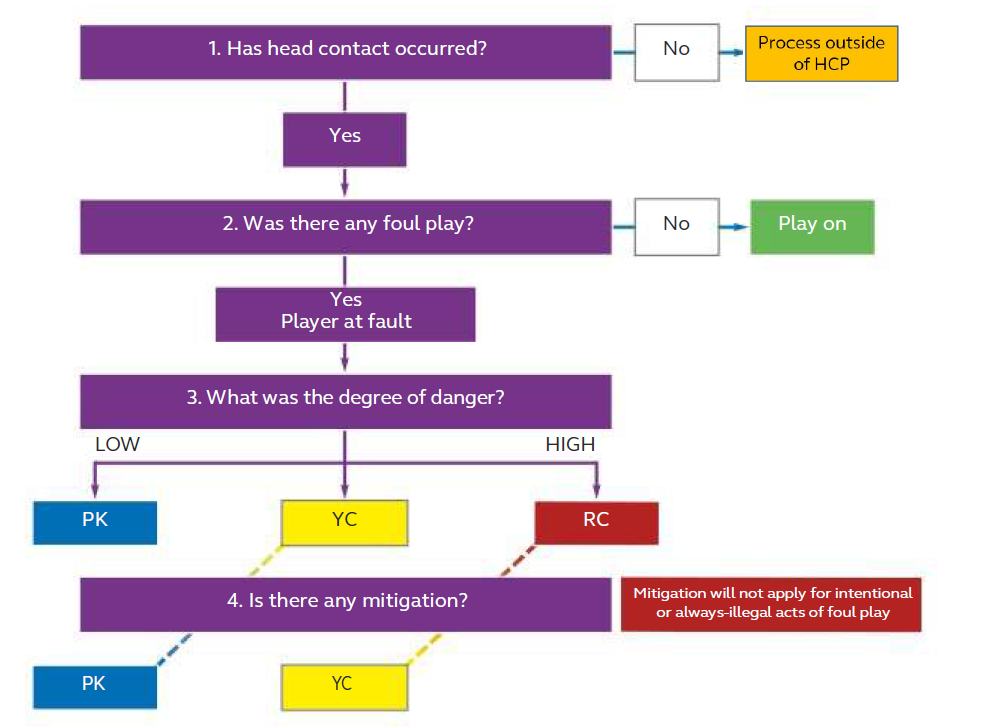Head Contact Process - March 2021
This has been updated since 2021. See March 2023 update:
Download this guideline as a PDF
View video examples of the Head Contact Process for: High Tackle|guidelines/18 Shoulder Charge|guidelines/19 Dangerous cleanout|guidelines/20 Head on head|guidelines/21 Leading elbow / forearm|guidelines/22
Context
Player welfare drives World Rugby’s decision making for zero tolerance of foul play, especially where head contact occurs.
The focus must be on the actions of those involved, not the injury - the need for an HIA does not necessarily mean that there has been illegal head contact.
Not all head contacts are foul play
Accidental contact with the ball-carrier tackled into the defender
‘Friendly fire’ as the two defenders clash heads
Absolutely accidental head clash between white 15 and red 14 - both competing for the ball at the same height
The ‘power of choice’ for tacklers is crucial, especially as 72% of head injuries occur in the tackle.
Gold 12 drops his weight down and through the low tackle attempt from black 15
White 8 braces to present all the hard points, bouncing off green 2’s low tackle attempt
Green 8 braces to present all the hard points, bouncing off red 8’s low tackle
There needs to be an understanding that tacklers stay up to allow them to ‘adjust and react’ - dropping quickly into the low tackle entry position - using their ‘eyes and feet’ to get their timing right.
It is important that coaches and players continually develop safe tackling techniques in training.
Aims of the Head Contact Process
The process is designed to protect the head, neck and throat area of players.
The process can be applied to:
- High tackles
- Shoulder charges
- Dangerous cleanouts
- Head-to-head collisions
- Leading elbow / forearm
The Head Contact Process is a Law Application Guideline. Under 9.11, the referee is always entitled to issue a red or yellow card for anything deemed to be reckless or dangerous. However, this process is intended to aid consistency in the application of sanctions by providing guidance on how contact with the head should be approached by match officials and disciplinary personnel.
This includes head-on-head
Process questions and considerations
1. Has head contact occurred?
Head contact includes neck and throat area
2. Was there foul play?
Considerations:
- Intentional
- Reckless
- Avoidable
3. What was the degree of danger?
Considerations include:
- Direct vs indirect contact
- High force vs low force
4. Is there any mitigation?
Considerations include:
- Line of sight
- Sudden and significant drop or movement
- Clear attempt to change height
- Level of control
- Upright - passive vs dynamic
Mitigation will not apply for intentional or highly reckless acts of foul play
Trigger words for match officials
Match officials may wish to use the non-exhaustive list of trigger words below to help them identify whether a player is at fault, the degree of danger involved and whether any mitigation should be applied.
Play on
No fault
- Sudden and significant drop in height by the ball carrier
- Player had no time to readjust
- Passive action
- Involuntary collision
- No leading arm when close to the body
PK
YC
Low danger
- Indirect contact
- Low force
- Low speed
- Passive
- No leading head / shoulder / forearm
RC
High danger
- Direct contact
- Lack of control
- High speed
- Upright and dynamic
- Leading head / shoulder / elbow / forearm
- Swinging arm
- No mitigation for intentional or highly reckless act of foul play
Mitigation
- Sudden / significant drop in height or change in direction from ball carrier
- A late change in dynamics due to another player in the contact
- An effort to wrap / bind and having no time to adjust